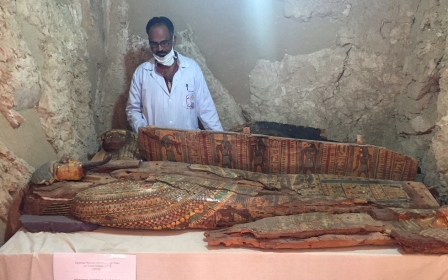17 mummies discovered in central Egypt: Ministry

Egyptian archaeologists have discovered 17 mummies in catacombs in Minya province, south of Cairo, the antiquities ministry announced on Saturday.
"We found catacombs containing a number of mummies," said Salah al-Kholi, a Cairo University professor of Egyptology who headed the mission that made the discovery in the Touna el-Gabal district of the province in central Egypt.
Burial shafts were found in the area and excavation work "revealed that these shafts led to a number of corridors inside a cachette of mummies," the ministry said.
It said in a statement that the cachette housed 17 non-royal mummies.
Kholi told a news conference held near the archaeological site in the desert that the discovery was "the first human necropolis found in central Egypt with so many mummies".
The discovery was "important, unprecedented, because it's the first human necropolis" to be found in the area, Mohamed Hamza, director of excavations for Cairo University.
The Touna el-Gabal site dates back to the Greco-Roman period between the third century BC and third century AD.
The discovery follows on the heels of the uncovering of several mummies, colourful wooden sarcophagi and more than 1,000 funerary statues in a 3,500-year-old tomb near the city of Luxor in April.
The 18th dynasty tomb, discovered in the Draa Abul Nagaa necropolis near the famed Valley of the Kings, belonged to a nobleman named Userhat who worked as the city judge.
It was opened to add more mummies during the 21st dynasty, about 3,000 years ago, to protect them during a period when tomb-robbing was common.
Middle East Eye propose une couverture et une analyse indépendantes et incomparables du Moyen-Orient, de l’Afrique du Nord et d’autres régions du monde. Pour en savoir plus sur la reprise de ce contenu et les frais qui s’appliquent, veuillez remplir ce formulaire [en anglais]. Pour en savoir plus sur MEE, cliquez ici [en anglais].




